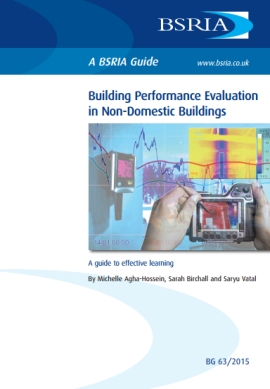Building performance evaluation in non-domestic buildings guide – an introduction to the tests and methods in non-domestic buildings
In September 2015, BSRIA published Building Performance Evaluation in Non-Domestic Buildings Guide – an introduction to the tests and methods in non-domestic buildings.
The guide provides a general introduction to Building Performance Evaluation (BPE), explains why it is important and how it can be carried out. BPE is a form of Post-Occupancy Evaluation (POE) which can be used at any point in a building's life to assess energy performance and occupant comfort and to make comparisons with design targets.
BPE is a key element of the BSRIA soft landings framework intended to help deliver buildings that are effective and efficient and perform as expected. The guide focuses on new, existing and refurbished non-domestic buildings and aims to inform those involved in the design, construction, operation and/or management of a building about its current performance.
The guide discusses some of the tests and methods that can be included when reviewing building performance to provide information about:
- Building fabric.
- Building services and operating strategies.
- Energy use.
- Handover and commissioning processes.
- Occupant satisfaction.
- Occupant comfort conditions.
It suggests that the following factors should be considered when structuring a BPE study:
- Management of building services.
- Nature of occupancy.
- Comfort and controls.
- Indoor air quality.
Catherine England, BSRIA Marketing Officer, said: “Despite genuine intentions to develop efficient buildings, the construction industry is still missing the mark. Recent research from academia and industry has shown that buildings do not always perform in the way that was originally intended. This results in inefficiencies in energy performance, and occupant dissatisfaction. BPE is the process of evaluating how a building performs and can be used on both new and existing buildings in order to address these issues. The publication captures this process.”
NB BSRIA suggest that, “Post-occupancy evaluation (POE) constitutes the activities of the BPE process once the building is occupied and in use, focussing on the operational performance and the occupants of the building. It is important to know to what extent the building maintains its occupants’ satisfaction and perceived comfort. To do this in a systematic and structured way, post-occupancy evaluation (POE) can be employed as a major part of BPE. This would involve collecting feedback (soft data) from the occupants through survey questionnaires, interviews and / or workshops, ideally at least one year after building occupation to cover at least on seasonal cycle.
--BSRIA
[edit] Related articles on Designing Buildings Wiki
- Building performance evaluation.
- Building performance evaluation in domestic buildings.
- Building performance metrics.
- Client commissioning.
- Defects liability period.
- Extended aftercare.
- Handover to client.
- Initial aftercare.
- Lessons learned report.
- Performance in use.
- Post occupancy evaluation.
- Post occupancy evaluation process.
- Post project review.
- Smart meters and building performance evaluation.
- Snagging.
- Soft landings.
- Soft Landings for owners.
Featured articles and news
Key points for construction at a glance with industry reactions.
Functionality, visibility and sustainability
The simpler approach to specification.
Architects, architecture, buildings, and inspiration in film
The close ties between makers and the movies, with our long list of suggested viewing.
SELECT three-point plan for action issued to MSPs
Call for Scottish regulation, green skills and recognition of electrotechnical industry as part of a manifesto for Scottish Parliamentary elections.
UCEM becomes the University of the Built Environment
Major milestone in its 106-year history, follows recent merger with London School of Architecture (LSE).
Professional practical experience for Architects in training
The long process to transform the nature of education and professional practical experience in the Architecture profession following recent reports.
A people-first approach to retrofit
Moving away from the destructive paradigm of fabric-first.
International Electrician Day, 10 June 2025
Celebrating the role of electrical engineers from André-Marie Amperè, today and for the future.
New guide for clients launched at Houses of Parliament
'There has never been a more important time for clients to step up and ...ask the right questions'
The impact of recycled slate tiles
Innovation across the decades.
EPC changes for existing buildings
Changes and their context as the new RdSAP methodology comes into use from 15 June.
Skills England publishes Sector skills needs assessments
Priority areas relating to the built environment highlighted and described in brief.
BSRIA HVAC Market Watch - May 2025 Edition
Heat Pump Market Outlook: Policy, Performance & Refrigerant Trends for 2025–2028.
Committing to EDI in construction with CIOB
Built Environment professional bodies deepen commitment to EDI with two new signatories: CIAT and CICES.
Government Grenfell progress report at a glance
Line by line recomendation overview, with links to more details.
An engaging and lively review of his professional life.
Sustainable heating for listed buildings
A problem that needs to be approached intelligently.
50th Golden anniversary ECA Edmundson apprentice award
Deadline for entries has been extended to Friday 27 June, so don't miss out!
CIAT at the London Festival of Architecture
Designing for Everyone: Breaking Barriers in Inclusive Architecture.
Mixed reactions to apprenticeship and skills reform 2025
A 'welcome shift' for some and a 'backwards step' for others.




























